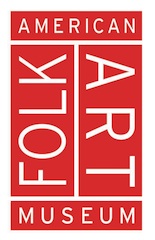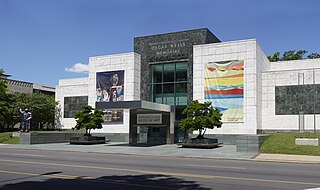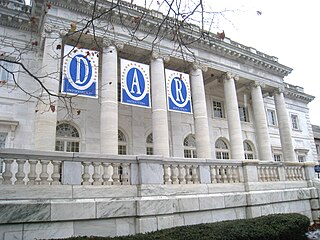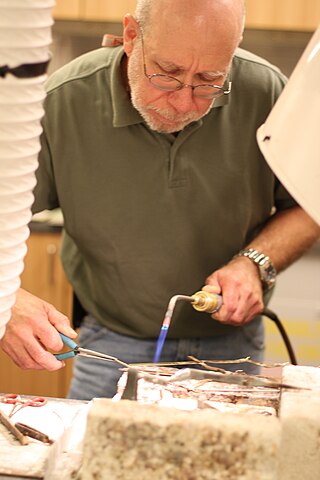Description
Permanent exhibits include the Instruments of American Excellence (IAE) (opened September 2012), the life of Duncan Hines, a look at the Civil War from a local perspective, a decorative arts gallery ranging from an Egyptian sarcophagus to 1970s macramé, plus a gallery of regional quilts. Changing galleries display a variety of themes, with community exhibitions, university-class designed and installed exhibitions, and some annual events, like the open art show. In addition, the 1815 Log House displays building techniques, furniture, tools, and clothing authentic to the 1810s time period. Hands-on programs for school classes and educational workshops for adults, lectures, and festivals are also regularly featured at the Kentucky Museum.
The IAE exhibit is unique among museums: its purpose was to collect the ordinary means by which Americans have achieved extraordinary things: the actual tools or instruments that have helped change the course of our nation's history. The IAE includes items that belonged to Madeleine Albright, Daniel Boone, Jimmy Carter, Tony Hawk, Roger Ingram, Helen Keller, Liza Minnelli and many more.

The Victoria and Albert Museum in London is the world's largest museum of applied arts, decorative arts and design, housing a permanent collection of over 2.27 million objects. It was founded in 1852 and named after Queen Victoria and Prince Albert.
The Peel Art Gallery, Museum and Archives (PAMA) is a museum, art gallery, and archives for the Regional Municipality of Peel and are located in Brampton, Ontario, Canada. Previously, it was the Peel Heritage Complex. Its facilities were originally the Peel County Courthouse, Brampton Jail, a land registry office, and a county administration building. It is opposite Gage Park and Brampton City Hall.

The Carnegie Museum of Art, is an art museum in the Oakland neighborhood of Pittsburgh, Pennsylvania. Originally known as the Department of Fine Arts, Carnegie Institute and was at what is now the Main Branch of the Carnegie Library of Pittsburgh. The museum's first gallery was opened for public use on November 5, 1895. Over the years the gallery vastly increased in size, with new a new building on Forbes Avenue in 1907. In 1963, the name was officially changed to Museum of Art, Carnegie Institute. The size of the gallery has tripled over time, and it was officially renamed in 1986 to "Carnegie Museum of Art" to clearly indicate it as one of the four Carnegie Museums.

The American Folk Art Museum is an art museum in the Upper West Side of Manhattan, at 2, Lincoln Square, Columbus Avenue at 66th Street. It is the premier institution devoted to the aesthetic appreciation of folk art and creative expressions of contemporary self-taught artists from the United States and abroad.

The Birmingham Museum of Art is a museum in Birmingham, Alabama. Its collection includes more than 24,000 paintings, sculptures, prints, drawings, and decorative arts representing various cultures, including Asian, European, American, African, Pre-Columbian, and Native American. The museum also is home to a collection of Renaissance and Baroque paintings, sculpture, and decorative arts from the late 13th century to c. 1750.

Shelburne Museum is a museum of art, design, and Americana located in Shelburne, Vermont, United States. Over 150,000 works are exhibited in 39 exhibition buildings, 25 of which are historic and were relocated to the museum grounds. It is located on 45 acres (18 ha) near Lake Champlain.

The Huntington Museum of Art is a nationally accredited art museum located in the Park Hills neighborhood above Ritter Park in Huntington, West Virginia. Housed on over 50 acres of land and occupying almost 60,000 square feet, it is the largest art museum in the state of West Virginia. The museum's campus is home to nature trails and the C. Fred Edwards Conservatory, a subtropical and tropical plant conservatory. The museum's collection includes American and European paintings, sculptures, prints, and drawings, as well as glass pieces manufactured in West Virginia and the Ohio Valley, American folk art, Chinese and Japanese decorative objects, Haitian art, firearms, and decorative arts from the Near East. In addition to its permanent collections, the museum hosts traveling exhibitions and houses the James D. Francis Art Research Library, the Grace Rardin Doherty Auditorium, and five art studios where artists in residence are periodically hosted and classes are held. The Huntington Museum of Art holds one of the largest collections of art in the state of West Virginia.

The Brukenthal National Museum is a museum in Sibiu, Transylvania, Romania, established in the late 18th century by Samuel von Brukenthal (1721-1803) in his city palace. Baron Brukenthal, governor of the Grand Principality of Transylvania has established his first collections around 1790. The collections were officially opened to the public in 1817, making the museum the oldest institution of its kind on the territory of modern-day Romania.
Quilt art, sometimes known as art quilting, mixed media art quilts or fiber art quilts, is an art form that uses both modern and traditional quilting techniques to create art objects. Practitioners of quilt art create it based on their experiences, imagery, and ideas, rather than traditional patterns. Quilt art generally has more in common with the fine arts than it does with traditional quilting. Quilt art is typically hung or mounted.

The Johnson-Humrickhouse Museum is a general interest museum within historic Roscoe Village, a restored Ohio & Erie Canal town in Coshocton, OH. It has four permanent themed exhibits within five galleries, including a Native American Gallery, Historic Ohio, Asian, and 19th and 20th Century Decorative Arts. There are more than 17,000 items in its collections.

Brighton Museum & Art Gallery is a municipally-owned public museum and art gallery in the city of Brighton and Hove in the South East of England. It is part of the "Royal Pavilion & Museums, Brighton and Hove". It is free for local residents but charges £7.50 per non-resident for a yearly pass.

The Quilt National is a juried biennial exhibition of contemporary quilt art, first held in 1979. The primary exhibition is held at the Dairy Barn Art Center in Athens, Ohio in odd-numbered years. The exhibition includes between 80-90 quilts. After the conclusion of the Quilt National, selections of the exhibits also tour the country. It is both the largest and one of the most prestigious shows of its kind.

An exhibition, in the most general sense, is an organized presentation and display of a selection of items. In practice, exhibitions usually occur within a cultural or educational setting such as a museum, art gallery, park, library, exhibition hall, or World's fairs. Exhibitions can include many things such as art in both major museums and smaller galleries, interpretive exhibitions, natural history museums and history museums, and also varieties such as more commercially focused exhibitions and trade fairs.

The Brigham City Museum of Art & History, also known as the BCMG or, formerly, the Brigham City Museum-Gallery, is an art museum and history museum in Brigham City, Utah. The museum is a department of Brigham City Corporation, but also has a non-profit foundation, the Box Elder Museum Foundation, Inc.

The Museum of Applied Arts is a museum in Leipzig, Germany. It is the second oldest museum of decorative arts in the country, founded just six years after the Kunstgewerbemuseum Berlin. Today it is part of the Grassi Museum, an institution which also includes the Museum of Ethnography and the Museum of Musical Instruments, based in a large building on the Johannisplatz.

The DAR Museum, run by the Daughters of the American Revolution, is an art and history museum in Washington, D.C. The museum is located in Memorial Continental Hall, just down the street from DAR Constitution Hall, where some of the museum's concerts take place.

A mount maker is responsible for the creation of structures called object mounts used to provide unobtrusive physical support, stability, and security of objects while on display, in storage, or being transported to museums, art galleries, libraries, archives, botanical gardens or other cultural institutions. Protection and long-term conservation of the object is a key goal of mount makers. This is accomplished through careful design, selection of materials and manufacturing process that will not inadvertently harm the object, and a cautious installation process of the object into its place in an exhibit. Professionals in this field can be employed directly by an institution, be independent contractors, or work as part of larger cultural institution exhibit design firms.

Archaeological and historical finds, as well as contemporary works of art are displayed in the museums and exhibitions at Mount Olympus.
Bisa Butler is an American fiber artist who has created a new genre of quilting that has transformed the medium. Although quilting has long been considered a craft, her interdisciplinary methods -- which create quilts that look like paintings -- have catapulted quilting into the field of fine art. She is known for her vibrant, quilted portraits celebrating Black life, portraying both everyday people and notable historical figures. Her works now count among the permanent collections at the Smithsonian National Museum of African American History and Culture, the Art Institute of Chicago, and about a dozen other art museums nationwide. She has also exhibited at the Smithsonian Museum of American History, the Epcot Center, the National Underground Railroad Freedom Center, and many other venues. In 2020, she was commissioned to quilt cover images for Time magazine, including the "Person of the Year" issue and its "100 Women of the Year" issue. With a multi-year wait list for private commissions, one of Butler's quilts sold at auction in 2021 for $75,000 USD.

Linda Gass is an American environmental activist and artist. She is known for her brightly colored quilted silk landscape sculptures, which reflect her passion for environmental preservation, water conservation and land use. She uses art as a tool to spark interest in ecological matters, raise environmental consciousness, and promote a deeper understanding of the issues presented. Gass' works are influenced by wilderness areas in the western parts of America, of which she creates works of juxtapositions of vulnerability and resilience of the human-environmental experience. In addition, she creates juxtapositions of the future versus the past. These ideas are portrayed through her primary visual art media such as silk paintings and glass sculptures. Her personal interest in water conservation developed while seeking to understand how the drought-stricken area of California in which she was raised was perennially lush, despite the lack of rainfall.

















